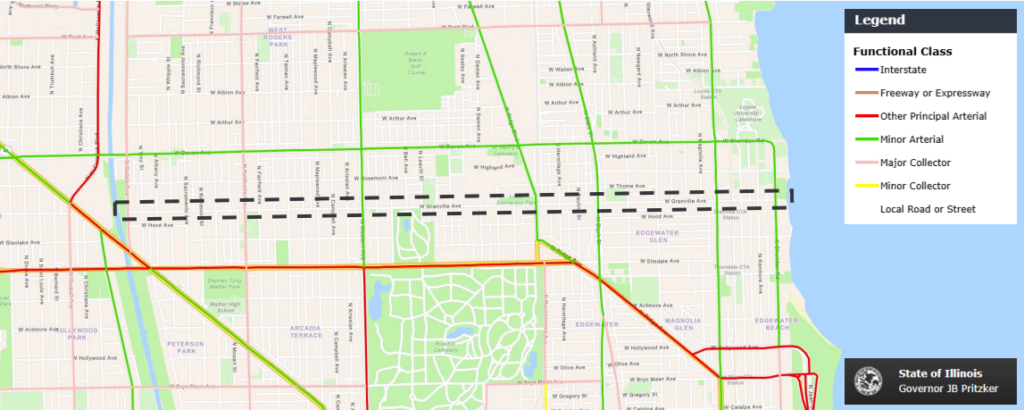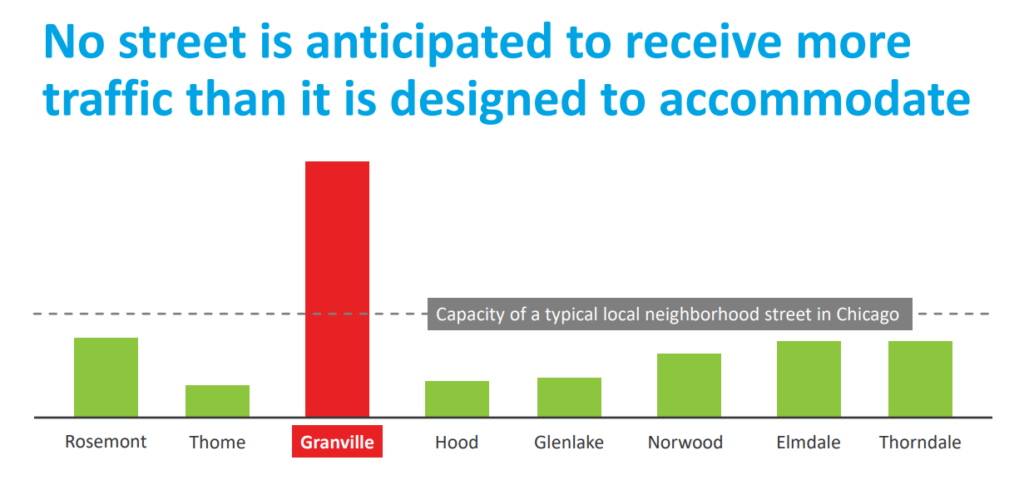
On Thursday, February 13th, our office hosted a virtual follow-up meeting on Granville Traffic Safety with the Chicago Department of Transportation (CDOT) and the 48th Ward. If weren’t able to make the meeting, you can view a recording!
Here’s what we learned:
Granville continues to be a traffic safety hot spot.
Since the first community meeting in October, there have been:
- 63 crashes
- 14 people injured
- 16 hit and run crashes
Nearly half of these crashes occurred during school pick-up and drop-off, and at least one of those crashes involved a child.
Design Updates
CDOT updated the initial design to include traffic calming and one-way conversions at key intersections, including:
- Traffic calming / pedestrian safety elements at 7 intersections
- Short one-way conversions to discourage non-local traffic
- New speed humps on 11 blocks
- Refreshed crosswalk markings
- Replace missing corner clearance signage
- Bike route pavement markings and signage
To see plans for specific intersections, view CDOT’s Complete Streets presentation.
Q&A
CDOT collected some of the most common questions they heard from the community, and answered them:
Why are there so many crashes on Granville?
Granville is not wide enough to accommodate the volume of traffic it experiences, which is 2-3 times the daily traffic of a typical neighborhood street.
Isn’t Granville a “Collector Street?”
No. Granville is a local neighborhood street. The Federal Highway Administration (FHWA) classifies streets based on their function and hierarchy within the street network. Granville is recognized by the FHWA, Illinois Department of Transportation (IDOT), and CDOT as a Local Street. Local Streets “are not intended for use in long distance travel… They are often designed to discourage through traffic.” (FHWA)

Granville cannot be reclassified as a collector street, because it does not meet the width requirements set by the FWHA and IDOT for Collector Streets. Granville is considerably narrower than formally designated Collector Streets in Chicago (up to 14-feet narrower in some stretches). The mismatch between the narrow width and high volume of vehicles contributes to the high number of crashes occurring on Granville. Local neighborhood streets are not designed to support the number of vehicles that currently use Granville each day.
Can you achieve the same project goals with only traffic calming elements (e.g. traffic circles)?
No. Granville requires a more comprehensive approach. The number of vehicles that use Granville each day far exceeds the volume of traffic a local neighborhood street is designed to accommodate. To properly address traffic safety, we must reduce the number of non-local trips using Granville; encourage safe, consistent, and predictable speeds; and better organize Granville for all the many ways people travel on Granville.
Will this impact emergency services?
No. Emergency access will be preserved. Our office and CDOT have shared the design with CFD for their feedback. All intersections are designed to the specifications of the largest Chicago Fire Department vehicles. Emergency services can travel in all directions. The reduced traffic volumes and better organization of remaining traffic on Granville are anticipated to improve the operations of emergency services by reducing any delays currently experienced today.
How will this proposal impact traffic in the neighborhood?
At key intersections including Sheridan, Broadway, Clark, Ravenswood, and Western, 1-2 block sections will be converted to one-way to discourage non-local traffic.

At those intersections eastbound traffic will be filtered onto Western, Ridge, and Clark. Westbound traffic will be filtered onto Broadway and Clark. They will then likely be diverted to arterial streets like Peterson Avenue which are equipped for the volume of traffic that Granville now receives.
Granville is unique among neighbor streets, in that it is 2-way for an almost 16 mile stretch. Most of the other neighborhood streets either incorporate one-ways, or are not through streets, so they are unlikely to receive more traffic than they are designed to accommodate.

To view additional Q&A, as well as previous meeting materials, visit the Granville Complete Streets project page.
Community Support
76% of the attendees of the last meeting expressed support for the project. Here is some of the feedback that neighbors provided to CDOT:
- The data presented confirms my experience using Granville
- Cars don’t stop at stop signs
- I don’t feel safe travelling on Granville with my family
- I was hit by a car while travelling on Granville
- My child was hit by a car while biking to school on Granville
- I first thought the one-way changes were too aggressive, but after spending time watching traffic on Granville, this seems like the only way to make Granville safer.
In the 40th Ward office, the majority of neighbors we heard from The project is also supported by local schools, including Hayt Elementary.
Timeline and Next Steps
Our office, CDOT, and the 48th and 50th Wards are committed to improving traffic safety on Granville this year. Especially given that a child was recently hit outside of Stone Elementary, we feel a sense of urgency to make these changes before any other serious injuries occur.
Construction for this project is tentatively scheduled to begin in the Summer 2025, and will coincide with CPS summer break to minimize disruption for schools.
To sign up for updates on the project, visit the Granville Project Page, and subscribe to updates. Once construction is scheduled, we will update the community with a timeline and weekly updates.